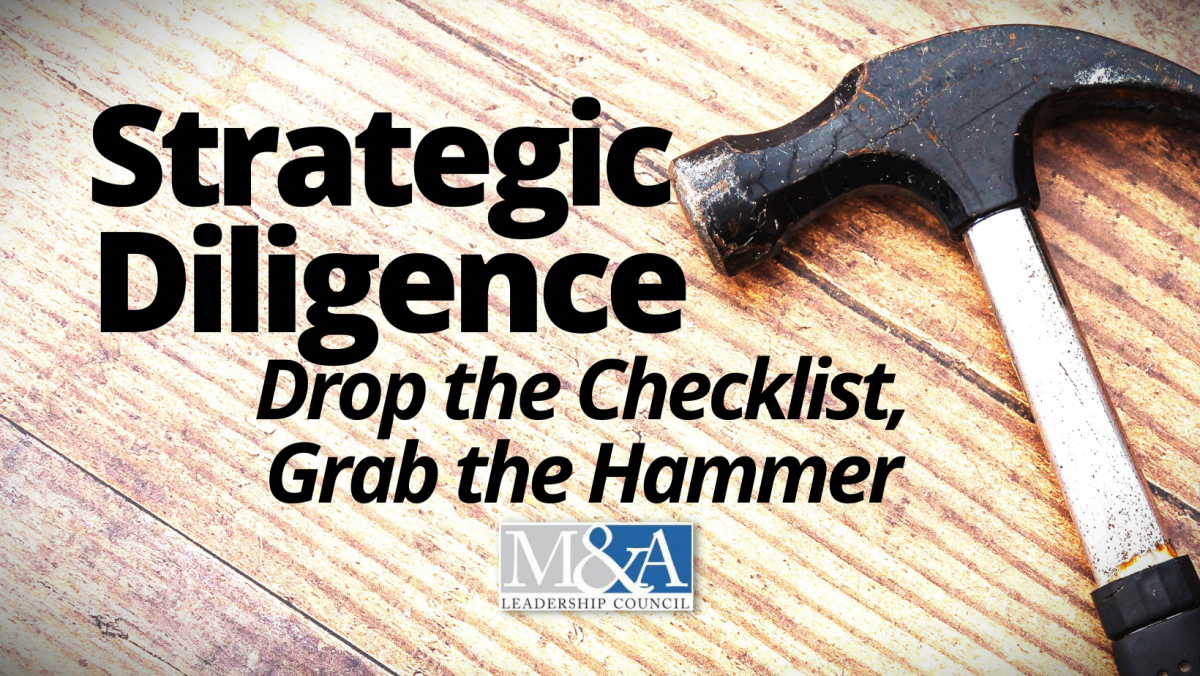
Hammering the "So What" About the Most Important Areas
by Jack Prouty, Past President, M&A Leadership Council
A young couple had a problem with their kitchen sink and called in a plumber to fix it. He presented them with a bill for $100, and the husband asked for a price breakdown.
The plumber wrote, “$10 for hammering, $90 for knowing where to hammer.”
This story illustrates a key point in conducting an effective assessment/strategic diligence of a company you are looking to acquire.
It's not a matter of having an 18-page checklist covering every possible question you have about the target company; it's about “hammering” the most important areas you need to know about this company in terms of the true value of this business and the potential risks to realizing that value. Too many companies have a “checklist” mentality for the due diligence phase rather than a “business fit and value” mentality.
I try to simplify things when I approach a due diligence, by following the key points we make during our training sessions, "The Art of M&A® for Due Diligence Leaders” and “The Art of M&A® for Integration Leaders.” For those who have attended our seminars or read previous articles by the Council, I recommend that you again refer to this material as a reminder:
- Why are we acquiring this company? (Refer to the articles and the workshop material Mark Herndon covers on Deal-Type DNA.)
- The need to look beyond and behind the financial numbers in diligence (as presented in the session The Art of M&A® for Due Diligence Leaders by Tony Enlow ).
- What is the business fit and value assessment? (Refer to the articles and the workshop material that I have presented on Strategic Diligence: Business Fit and Value.)
- What are the key areas of business risk, value erosion, and dis-synergies in the deal? (Refer to the case study material presented in our training sessions.)
One simple thing we teach that resonates with our attendees as a best practice for critical thinking is to continually be asking the “SO WHAT” question. In other words, we should be asking for less information and focusing on the most important “need to know” and do a better analysis/assessment of that information.
For example, we all ask for the current organization chart of the target company. However, what do most of us do with this information? Not much, unless we know how to highlight some crucial information for a deeper probe of the target:
- What does this chart tells us about how they are organized versus how we are organized?
- Does it show some functions they have that we don’t, and vice versa?
- Does it indicate some major disconnects between our two business models, understanding that the bigger the gap, the greater the complexity and challenges in integrating the businesses?
- Does it illustrate how they face the customer? Whether they are internally versus externally focused? Whether they are organized by product line, business segment or geography?
This is just one example of the type of thought process I would recommend you follow to improve your due diligence effectiveness.
I leave you with one last story to illustrate my point. In one of our training sessions, conducted a few years ago, I had covered this topic: that for every piece of data collected in due diligence you should ask the question, “So what?” What does this mean in terms of value, risks, integration issues, and potential synergies and costs?
It so happened that shortly thereafter, one of our attendees had to jump on a call with her team to review current diligence work being performed. During that call, for every report-out on findings she asked the question, “So what?” She stated later that it changed the whole tenor of the discussion and refocused the team on what were the most important items to be addressing in the diligence.
Sometimes a question a simple as “So what” can dramatically improve what gets done, and how it gets done, across the life cycle of an M&A.
###
Learn more about the "So Whats" of Due Diligence and the M&A Lifecycle at our two upcoming in-person training events:
These sessions include face-to-face networking with presenters, peer interaction, small-group breakouts, team challenges, roundtable discussions and more. Join us!
The Art of M&A® for Due Diligence Leaders / In-Person / Boston, MA / Sep 2023 - September 12-14, 2023
The Art of M&A® for Integration Leaders / In-Person / San Diego, CA / Oct 2023 - October 11-13, 2023